Part 1 of a 7-Part Series on contamination at a Maryland Navy Base
The Navy has contaminated the groundwater at Maryland’s Patuxent (Pax) River Naval Air Station with 1,137.8 parts per trillion (ppt) of per- and polyfluoroalkyl substances (PFAS), according to a report published last July by the engineering firm CH2M Hill – See Figure 4 SITE 34 DRUM DISPOSAL AREA NAS PATUXENT RIVER MD 05/04/2018 CH2M Hill Site 34 – CH2M Hill
Pax River routinely used aqueous film-forming foam (AFFF) in fire-fighting exercises and in fire suppression systems in buildings throughout the base. The foams contained carcinogens that were allowed to leach into the county’s groundwater. The Navy has known of the deadly impact these substances have on human health since the 1970’s but continued to use them. In recent years, flourine-free foams (3F) have been developed that have proven to be every bit as effective as AFFF. They are used throughout much of the world.
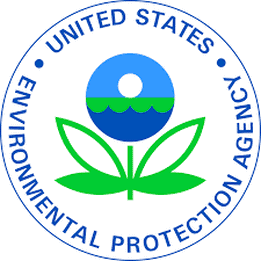
The EPA is asleep at the switch.
PFAS have been associated with a variety of cancers and are known to jeopardize human reproductive health. The contamination at Pax River was omitted from the Defense Department’s March 2018 Report on bases and communities contaminated with PFAS.
There are no restrictions currently on military or industrial PFAS discharges under either the federal Clean Water Act or the federal Clean Air Act. The Environmental Protection Agency (EPA) has issued a non-binding, non-regulatory advisory to states and municipalities of 70 parts per trillion (ppt.) in drinking water. Neither the military nor chemical companies are currently required to report releases of PFAS through the federal Toxic Release Inventory.
In the absence of a properly functioning EPA, fifteen states have developed guidelines for at least one PFAS analyte in at least one environmental medium. For instance, the groundwater in St. Mary’s County is 87 times higher than what New Jersey allows. The 241,000 ppt in the groundwater of Chesapeake Beach is 18,538 times what New Jersey allows. Maryland is behind the learning curve and current pending legislation, HB 619, which would regulate civilian uses of fire-fighting foam, barely scratches the surface. We must impose Maximum Contaminant Levels of 1 ppt, for all PFAS in all private and public drinking water. We also must begin testing all public systems and private wells. People living near military bases are dying from PFAS exposure.
The following narrative captures what we know from two engineer’s reports. One details the Site 34 Drum Disposal area located about1,500 feet from the intersection of Rt. 235 and Hermanville Rd. The other is a 129-page report on releases of PFAS covering the entire installation by CH2M Hill dated 07/01/18. (CH2M Hill Report) Following the description of this environmental destruction is a list of questions to ask Navy and Maryland public health officials at the Lexington Park Library on Tuesday, March 3, 5:00 – 7:00 pm. PFAS have been associated with a variety of cancers and are known to jeopardize human reproductive health. The contamination at Pax River was omitted from the Defense Department’s March 2018 Report on bases and communities contaminated with PFAS.
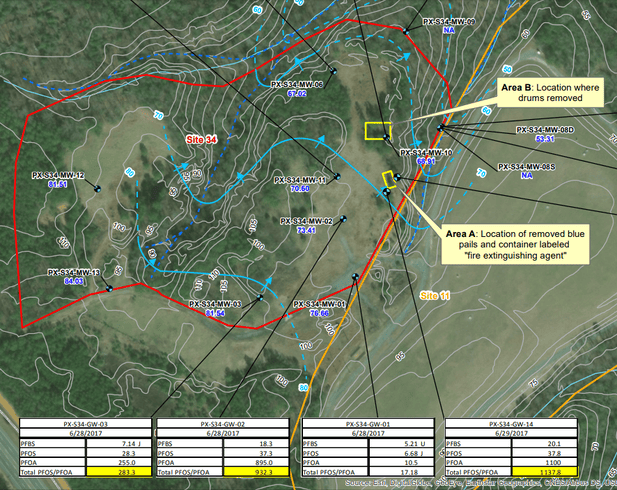
Site 34 is located in the southern portion of the station and occupies approximately 20 acres of partially cleared land. In 1996, a portion of the eastern hillside of Site 34 was excavated. This excavation revealed several buried 5-gallon plastic containers. In October 1997, an interim removal action was conducted in Areas A and B. It was during this removal action that an excavated blue plastic container had a partially legible label indicating it contained a fire-extinguishing agent, which could possibly contain PFAS.
In 2015, the Navy conducted well drilling and groundwater sampling to determine the presence or absence of PFAS in groundwater at Site 34. The characterization was based upon the historical evidence of the buried container found 18 years earlier that may have contained PFAS. In June 2017, the groundwater sampling was completed for three PFAS compounds (PFOS, PFOA, and PFBS) at two newly installed monitoring wells and nine existing monitoring wells all located on the 20-acre site at the southwestern corner of the base. PFOS and PFOA were detected across the site at concentrations above the USEPA Health Advisory Level of 70 parts per trillion for total PFOS and PFOA in nine of the eleven groundwater samples. PFOS + PFOA were found in concentrations of 1,138.8 ppt.
This level of contamination potentially poses a threat to the health of residents who drink water containing PFAS. Those who ingest well water and live near the base are particularly vulnerable. The 1,138.8 ppt of PFAS contamination of groundwater, however, is relatively small compared to other contaminated Navy bases and surrounding towns across the country.
Some navy bases, like China Lake Naval Air Weapons Station in California, have contaminated ground water at 8,000,000 parts per trillion. In Maryland, at a former United States weapons facility in Annapolis, drinking water supplies were tested in 2018 for the carcinogens. In 54 out of 68 wells, concentrations of PFOS/PFOA were found at 70,000 ppt. which is 1,000 times greater than the EPA’s health advisory. The Director of Public Works for the City of Annapolis who oversees drinking water said that he was not familiar with the contaminants. This may be one of the greatest crimes committed in the state’s history, although people are slow to catch on. That’s because the local press hasn’t been routinely covering the story. Site 34 is located in the southern portion of the station and occupies approximately 20 acres of partially cleared land. In 1996, a portion of the eastern hillside of Site 34 was excavated. This excavation revealed several buried 5-gallon plastic containers. In October 1997, an interim removal action was conducted in Areas A and B. It was during this removal action that an excavated blue plastic container had a partially legible label indicating it contained a fire-extinguishing agent, which could possibly contain PFAS.
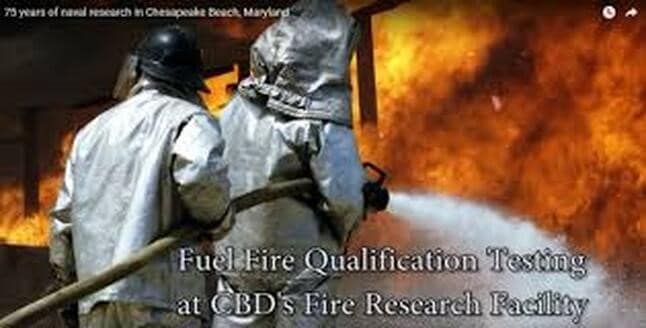
At the Naval Research Laboratory, Chesapeake Beach Detachment, the Navy has still not tested the well water of people who live a little more than 1,000 feet from burn pits used since 1968. The Maryland Department of Health, however, says it relies on the Navy to protect the health of Marylanders in this regard.
Forward to 11:50 in this NBC News documentary. Although the Washington Post, the Baltimore Sun, and the St. Mary’s Enterprise passed on the story, NBC thought the contamination at Pax River – and the refusal of Navy and local health officials to test wells in the community was newsworthy. And so, it begs the question – the one you’ll have to ask on March 3rd – why is it that the Navy is releasing information about PFAS contamination at Pax River at just one far-flung corner of the base?
AFFF was used at Site 41, the Fire Fighting Burn Pad from 1972 to 1991 for routine training. Pipes carried expired Jet fuel or waste oil to an old fuselage set in a 200 x 200-ft pit on a concrete pad. Massive fires were ignited and AFFF was allowed to infiltrate into the ground and discharge to surrounding storm water ditches and drains. An unknown amount of AFFF foam was released into the ground.
Similar fire training exercises at other bases have been known to discard 40,000 gallons of the carcinogens into the environment. The amount of foam likely dwarfs the relatively small amounts found at Site 34, but we don’t know for certain. Unlike other facilities, Pax River has not identified the level of PFAS contamination at these sites.
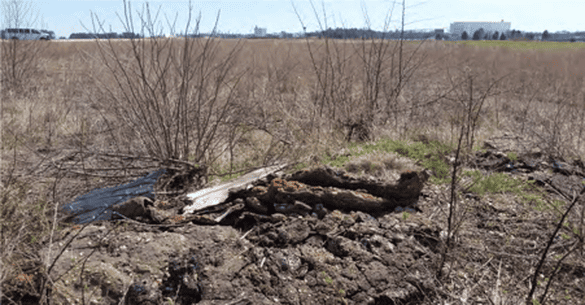
At Site 14, the Old Fire Fighting Burn Pad, AFFF was in use from 1970 to the early 1980s. Fires were ignited on concrete pads or in pits using a fuel. An unknown amount of AFFF foam was used to extinguish the flames and allowed to infiltrate into the ground and discharge to surrounding stormwater ditches and drains.

The CH2M Hill Report details 16 separate locations on base where AFFF were allowed to leach into the ground dating back to 1970. Nine of these are designated as high priority sites. They are briefly outlined here:
Hangar 110 Test Pilot School Aircraft Hangar – In April 2015, contents of a 2,200-gallon tank of AFFF concentrate for the suppression system was released due to mechanical failure. No one observed the release and the transport pathway is unclear, but AFFF concentrate was visibly seeping through the concrete and ponding in the adjacent stairwell/walkway area in between hangar bays.
Crash Trucks Daily Equipment Functioning Inspection Area Taxiway Alpha-Taxiway – Crash trucks from Bldg. 103 used this area for daily checks of AFFF spray equipment and consistency of foam. AFFF foam was allowed to infiltrate into the ground and discharge to surrounding stormwater ditches and drains. The amount of AFFF foam released is unknown.

Air Show Fire-Fighting Demonstration Area Center Airfield South was used for fire-fighting demonstrations during air shows starting in the early 1960s and ending in early 1970s. AFFF foam was used until 1973. Fires were created by dumping fuel around a fuselage to simulate an actual crash scene. The carcinogens were discharged to surrounding stormwater ditches and drains; the amount of AFFF foam released is unknown.

Building 103 – Air Operations Fire Station Fire Station 1 – Daily equipment checks and foam spray testing along with spills and leaks of AFFF concentrate potentially occurred here. An unknown amount of AFFF foam released
Building 2385 Hazardous Materials Storage Facility (HAZMART) – Multiple releases of AFFF concentrate from the suppression system in the building have resulted in up to 80 gallons of the materials released into the environment.
Hangar 2133 Joint Strike Fighter – Multiple releases of AFFF in 2002, 2005, and 2010 have occurred from the suppression system in the hangar. In at least one incident (date unknown) the entire system inadvertently went off. Exact quantities of AFFF concentrate and foam are unknown.
These suppression sprinkler systems are capable of covering a 2-acre hangar with 17 feet of carcinogenic foam in 2 minutes.
During the 2010 event, an unknown amount of AFFF foam entered the sanitary sewer leading to the METCOM facility via the bypass valve of the oil/water separator. METCOM had to shut off sewage flow and deal with reactivated AFFF in all the aeration basins. This incapacitated the treatment facility and potentially caused a host of problems discussed below.
AFFF has also been be pushed out of the hangar onto the grassy area southeast of the concrete apron. On at least two occasions AFFF could be seen moving down the storm culvert leading to the drainage ditch near Hangar 115 & Site 55.
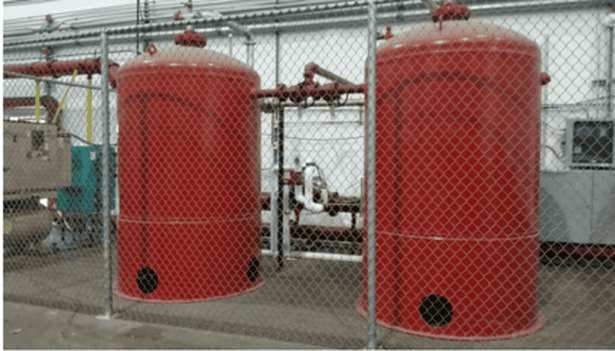
Hangar 2835 – is a temporary hangar with an AFFF suppression system. There have been several releases of AFFF foam from 2012 to 2015 due to spills, mechanical rupture in cold weather, and inadvertent activation of the system
Other releases:
- Building 1669 – 500 gallons emptied into METCOM sanitary sewer
- Hangar 2805 Presidential Helicopter – 400 gallons released into the ground
- Hangar 2905 Aircraft Prototype – One release in 2011 of 150 gallons went to the floor drain connected to the sanitary sewer leading to METCOM. A similar release of 150 gallons in November 2015 was confined to the system mechanical room and was stopped from going down the drain.
- Buildings 215 and 217 Engine Test Area – Unknown releases dating back to 1970.
- Building 102 Former Fire Station 2 – Unknown amounts of releases.
- Building 840 – Skeet Range, Aircraft Crash Site – Amount of AFFF used unknown
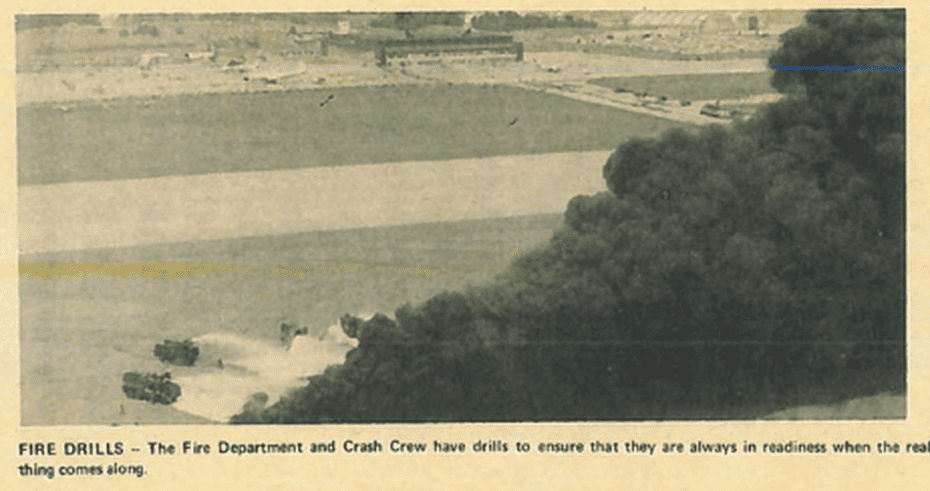
Surface Water
Although the Air Force regularly publishes the analytical results of PFAS in surface water – results that remain at surprisingly high levels 30 years after a base has closed – the Navy generally refuses to do so. Civic and press involvement in some communities, however, have caused the Navy to commit to testing the levels of contamination in surface water off base. Not so in St. Mary’s, where the community and the press have thus far been unconcerned with the level of the cancer-causing agents in the local waterways.
Goose Creek, Harpers Creek, West Patuxent Basin, East Patuxent Basin, Supply Pond, Gardiner Pond, the Patuxent River, and the Chesapeake Bay have been identified by the Navy as surface water bodies that have been contaminated with PFAS. Although not specifically mentioned in the report, St. Inigoes Creek, Smith Creek, and the St. Mary’s River are lalso impacted by the release of PFAS from Webster Field where the Navy has documented the use of PFAS in fire-fighting foam. We must demand that our precious waterways are tested for these “forever chemicals.”
The CH2M Hill Report states that groundwater discharges to surface water bodies, including ponds, streams, the Patuxent River, and the Chesapeake Bay. Groundwater flow from the surficial aquifer across the Station is predominately towards the Patuxent River and the Chesapeake Bay and away from residences and businesses. Using the word “predominantly’ leaves out the likelihood that groundwater flow may also cross Hermanville Rd. and Rt. 235.
The report says, “The potential impact of the PFAS releases on the surface water is likely low after extended periods of time since the releases and impacts to this media would be hard to determine.” This is easily refuted. The state of Michigan has issued a ban on taking deer near Wurtsmith AFB in Michigan because the venison is deemed to be poisonous due to high levels of PFAS. That base shut down in 1993. The deer drink from the streams that flow from the base. The Dallas Naval Air Station closed in 1998, although eating the poisonous fish caught in the vicinity is prohibited indefinitely. PFAS are known as forever chemicals. They don’t go away on their own – ever.
The report states, “The surficial aquifer is hydraulically connected to surface water that eventually discharge to the Patuxent River or the Chesapeake Bay. If the shallow aquifer is impacted by PFAS, it is assumed that any direct contact by receptors in the surface water bodies would be of minimum due to mixing.”
This is not a safe assumption. A “minimum” is all that is required to poison people.
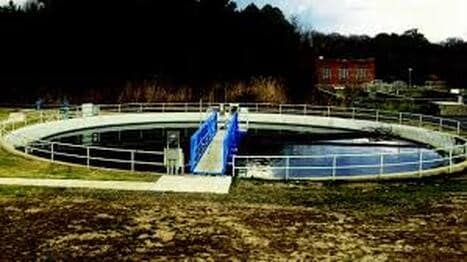
The engineer’s report states that AFFF was frequently discharged into the county’s sanitary sewer system. Hangar 2133, Building 1669, and Hangar 2905 have all emptied the forever chemicals into the county’s sanitary sewer system.
The sludge is disposed off-site at undisclosed locations where the carcinogens may leach into the groundwater. The EPA has still not set PFAS limits on sewer sludge, which is often applied to farm fields, contaminating crops, and providing a potent pathway to human ingestion. The St. Mary’s County Soil Conservation Service estimates that there are approximately 50,000 acres of cropland in St. Mary’s County of which approximately 50% are suitable for sludge disposal. The Marlay-Taylor Sanitary District Facility Plan estimates that approximately 807 tons of dried sludge will be produced per year.


2 comments
This is really f****d up. This is not even the human thing to do just letting people die of cancer rather than fixing the problem!
I was stationed there, so what does that mean in the 90’s?